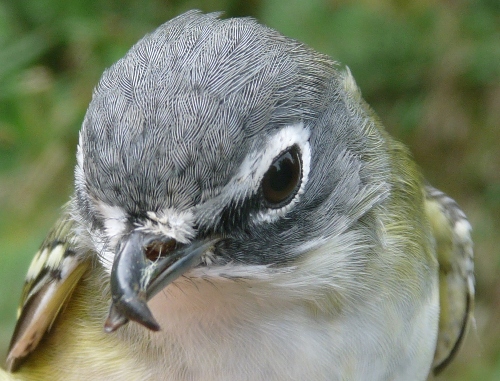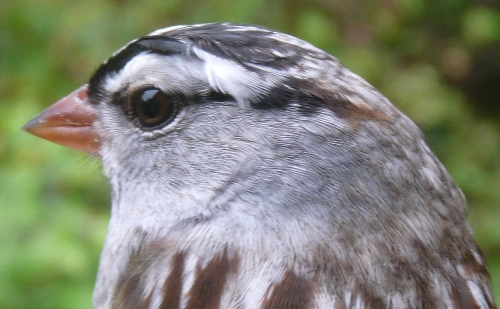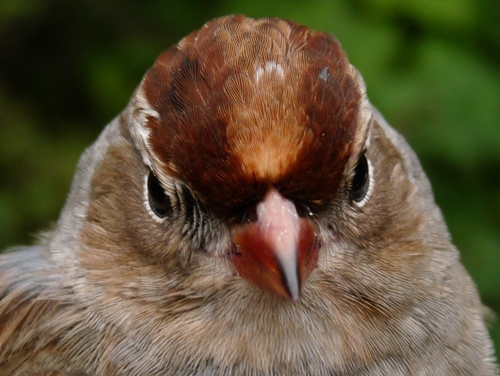|
McGILL BIRD OBSERVATORY |
||||||||||||||||||||||||||||||||||||||||||||||||||||||||||||||||||||||
Welcome
to the McGill Bird Observatory weekly report.
Click here for a complete listing of our archives.
Banders-in-charge: Bob Barnhurst, Simon Duval, Marcel Gahbauer, Gay Gruner Notes: We keep hoping that migration is just late this year, and the presence this week of several "mid-season" species such as Brown Thrasher, Tennessee Warbler, and American Redstart lent some credence to that belief. However, the counts were dominated by the usual early October species (kinglets, Yellow-rumped Warblers, White-throated and White-crowned Sparrows) - just in much smaller numbers than we are used to seeing. Last year at this time we had our third consecutive week with 1000+ individuals banded; this year over the seem period we have yet to hit a cumulative total of 1000! Overall, we've banded fewer than half as many birds as we had at this point last fall, though it's worth noting we have actually banded four more species this fall. While fall counts are largely dominated by hatch-year birds, and the lower numbers overall could therefore reflect a subpar breeding season, our returns are also way down this year, with only 24 individuals of 9 species to date, compared to 36 of 18 species by this time last fall.
For a second week in a row, our count of species observed was 81, and again it was a new record. This included our first diurnal record of Northern Saw-whet Owl, as well as our first Northern Pintail, Fox Sparrow, and American Tree Sparrow this fall. We banded our first Northern Saw-whet Owl ever as part of the Fall Migration Monitoring Program, thanks to an individual that was still flying around first thing in the morning. We also banded our first Fox Sparrow, Pine Siskin, and Brown Thrasher of fall (the latter quite a surprise, as we thought they were all long gone, but this keeps alive our streak of banding at least one each fall).
The top three species banded were the same as last week, although White-throated Sparrow and Ruby-crowned Kinglet swapped places. This trio has been on top during week 10 for three of the previous five years, but numbers were somewhat below average for all three species. Hermit Thrush, Song Sparrow, and White-crowned Sparrow numbers were also lower than expected for week 10. On the other hand, it was our second-best single-week count of Golden-crowned Kinglets ever, and our best ever weekly total for Brown Creeper. Tennessee Warbler finally dropped off the top ten list, although we banded four more this week to extend the record tally to 203 for the season. Others displaced from the top ten since last week were Blue Jay, Gray Catbird, and Chipping Sparrow. Similarly, there was little change among the most frequently observed species, with Canada Goose retaining a substantial lead over Red-winged Blackbird, while American Robin and American Crow swapped third and fourth place. White-throated Sparrow moved up to fifth place, though numbers were still a bit lower than the six-year average for this time of year, which is 68. A surprising new entry to the list was Pine Siskin, largely on the strength of a record flock of 150 individuals observed on Monday, and smaller but stil impressive counts of 85 on Wednesday and 45 on Thursday. Not only are these numbers much greater than we've ever observed at MBO, but it also marks the earliest appearance of Pine Siskins in fall, and makes us wonder what might lie ahead for winter in terms of finch movements. The siskin numbers are also particularly interesting given that American Goldfinches have been unusually scarce for most of fall. The rest of the top ten was relatively similar to last week; the only species that dropped off was Snow Goose.
In contrast to the disappointing week of passerine migration, it was a record-setting week for the saw-whet program. Conditions were still marginal on Monday night, and only one owl was banded. However, the persistent low pressure system finally lifted on Tuesday, and that night the owls flooded through, with 20 banded (a single night record for MBO) and also a foreign recapture banded in Pennsylvania in 2010. The next night was even better with 25 new owls and another foreign recapture, this one from Prince Edward Point, Ontario, banded in 2009. By the time Thursday rolled around, the 16 owls banded almost seemed like a quiet night! Numbers tapered off further as the week progressed, but all the same, the total of 75 banded was nearly double the previous single week record of 39 set in week 11 last fall.
|






